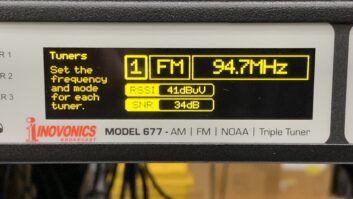
The author is the director of engineering services for the Alabama Broadcasters Association and chairman of the Alabama SECC. He can be reached at [email protected].
The Alabama State Emergency Communications Committee (SECC) is expanding the state’s EAS satellite network from 31 to 48 downlinks. These are strategically located at stations around the state to provide the widest distribution of alerts. There is no cost to the stations in the network.
The system, designed by Global Security Systems (GSS Net) and funded by the Alabama Broadcasters Association, was installed in 2011 to improve redundancy and reduce the amount of “daisy-chain” relay points in the state. The cost of the expansion is being shared by the ABA and the Alabama Emergency Management Agency.
[Read: Stakeholders Comment on Amendments to EAS]
“When an impending hazard is an immediate threat to Alabamians, a reliable alert and warning system is a critical component of state preparedness and mitigation,” said Alabama Emergency Management Agency Director Brian Hastings. “Each opportunity we have to improve warning time and reliability is an opportunity to save lives and property.”
Satellite receivers located at the 48 stations communicate with EAS units via a multicast protocol. Stations are still required to monitor two separate legacy sources. Those with a downlink have four sources to receive tests and alerts: the two legacy monitor sources, GSS Net and IPAWS. The chance of all four being down at the same time is unlikely. Maintenance of the satellite network is managed by the SECC and funded by the ABA. All the stations with downlinks are listed as LP-1.
The network is fully CAP-enabled and includes a secure portal for alert origination by approved agencies. It also is interfaced with the IPAWS network and WEA, which increases redundancy. When a state agency issues an alert, it goes to all downlinks within five seconds. Other features of the origination protocol include sending a test or alert to the entire state or to select counties. This is important for local area alerts and counties around the state’s two nuclear power plants. Recorded audio files can be attached to the alert, eliminating text to speech conversion. The receivers also include audio ports which were utilized during the last National Periodic Test (NPT), relaying the audio from a Sirius/XM receiver feeding the satellite audio channel.
The functionality of the network is constantly evaluated by the SECC which monitors over 150 EAS units around state. While the SECC’s monitoring of receivers does not take the place of the FCC requirements concerning station logs and chief operators, the SECC chairman works with local engineers when an error is observed in their EAS equipment.
ABA President Sharon Tinsley addressed the association’s role in the EAS distribution network, “We view this as one of the most important services we provide stations. In this way, we help equip them to provide alerts to their communities while remaining in compliance with FCC rules. By maintaining and monitoring the distribution network, we can assure operators that alerts will get to their stations.”






